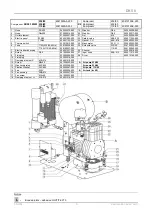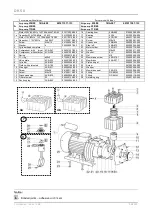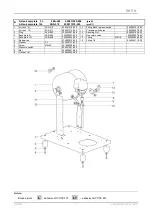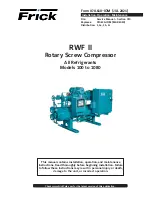
DK50
08/2014
- 11 -
SM-DK50-EN-1-08-2014-MD
9. SOLVING
PROBLEMS
Caution! Before proceeding, depressurize the air tank to zero and disconnect the
appliance from the mains.
For permanently high efficiency of drying, it is necessary to maintain the whole appliance, and
mainly ventilator clean – regularly clean the surface of ventilator and cooling fins of cooler.
Troubleshooting can be performed only by qualified personnel.
FAILURE POSSIBLE
CAUSE
REMEDY
Compressor does not
start
No voltage in pressure switch
Check voltage in socket
Check fuse – replace faulty one
Loosen terminal – tighten it
Check power cord – replace faulty one
Disconnected winding of motor, damaged
thermal protection
Faulty capacitor
Seizure of piston or another rotary part
Pressure switch does not switch on
Replace motor or re-wind it
Replace capacitor
Replace damaged parts
Check the function of pressure switch
Compressor often
switches on
Air leak in pneumatic distribution system
Leaking check valve
Greater volume of condensed liquid in
pressure vessel
Check pneumatic distribution system – seal
loose joint
Clean valve, replace seals, replace valve
Drain condensed liquid
Prolonged running of
compressor
Air leak in pneumatic distribution system
Worn piston ring
Contaminated input filter
Defective solenoid valve
Check pneumatic distribution system – seal
loose joint
Replace worn piston ring
Replace contaminated filter with the new one
Repair or change the valve
Compressor is noisy
(knocking, metal
noises)
Damaged bearing of piston, piston rod,
motor bearing
Loose or cracked spring
Replace damaged bearing
Replace damaged spring
Dryer doesn´t dry
(condensed water in
the tank)
inoperative cooler ventilator
replace ventilator
check supply of electric energy
Damaged dryer
Replace dryer
Dirty automatic condensate drain on filters
clean / replace
Dirty filter and micro-filter elements
Replace old elements with new elements
The internal surfaces of the air tank must be cleaned and all condensed liquid must be removed after a dryer
failure.
Check the dew point of the air leaving the air tank (see Chapter 3 - Technical Data) in order to
protect connected equipment from damage!






































